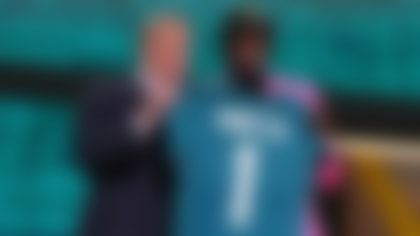The pass-happy nature of the NFL has put the spotlight prominently on WR1s, but the best offenses feature playmakers at the WR2 and WR3 positions. Defensive coordinators will attempt to neutralize the opponent's top weapon and force the quarterback to lean on a lesser-known playmaker.
When I played with the Kansas City Chiefs in the late 1990s under defensive coordinator Gunther Cunningham, we frequently directed our coverage to the opponent's WR1 and WR2, daring the quarterback to throw the ball to another pass catcher in key situations. Of course, it's easier to snuff out the offense's top options when you have a pair of Pro Bowlers (in our case, James Hasty and Dale Carter) blanketing receivers with aggressive bump-and-run tactics.
Nevertheless, the approach showed me that elite offenses must have a few unheralded playmakers on the roster to thrive against premier defenses in big games. With that in mind, I wanted to spotlight a handful of underrated pitch-and-catch combinations that could become quite prolific during the 2016 season. Here are my top five to watch:
5) Tom Brady to Chris Hogan (New England Patriots)
The Patriots' aerial attack should be tight end-centric, with Rob Gronkowski and Martellus Bennett poised to wreak havoc between the hashes, but Hogan could be the X-factor in the passing game as a versatile playmaker. The 6-foot-1, 220-pounder has the size and athleticism to fill a role as an "X" receiver (split end), or he could slide into the slot to give Brady another good-sized target over the middle. As a scrappy receiver with strong hands and superb route-running skills, Hogan should dominate CB4s from various alignments in the Patriots' exotic spread formations. Most importantly, he gives Brady another option when teams bracket or double-team Gronk in key situations.
When I asked an AFC East personnel director about Hogan's potential, he told me that the 27-year-old is a "perfect fit" in the offense, due to his versatility and ability to run three routes (option, short post and dig) that are featured prominently in the Patriots' playbook. Considering the importance of skill fit within the scheme, Hogan could become one of Brady's favorite targets in 2016.
4) Ben Roethlisberger to Sammie Coates (Pittsburgh Steelers)
The Steelers have become a playmaker factory in recent years, with the likes of Antonio Brown, Markus Wheaton and Martavis Bryant emerging as difference makers after entering the league as unheralded commodities. Part of the credit certainly goes to offensive coordinator Todd Haley (and WR coach Richard Mann) for teaching the youngsters the nuances of the position, but Roethlisberger also deserves kudos for trusting his unproven pass catchers in key situations.
With Bryant sidelined for the entire 2016 season due to a substance-abuse violation, Coates is in line to become a key contributor as the Steelers' WR3. The 6-1, 212-pounder flashed big-play potential (two receptions for 61 yards) as a fill-in for the injured Brown during the AFC Divisional Round. He should make a bigger contribution in Year 2, particularly as a deep-ball threat, with more opportunities available due to Bryant's absence on the perimeter. If he can avoid the "dropsies" that plagued his collegiate career at Auburn, Coates could become the Steelers' "vertical stretch" receiver on the back side of the formation.
3) Matthew Stafford to Theo Riddick (Detroit Lions)
The loss of Calvin Johnson will force the Lions to diversify their passing game with Stafford at the helm. The eighth-year pro no longer has the luxury of lobbing alley-oops to a 6-5, 237-pound Goliath on the perimeter, so he will need to adopt a traditional style from the pocket to succeed in a conference that features a number of stingy defenses. While most would expect more throws to head in the direction of Golden Tate and free-agent addition Marvin Jones, I believe the key to the Lions' passing game could be their dynamic third-down back. Riddick isn't necessarily a secret weapon after snagging 80 balls in 2015, but he could be a 100-catch player in an offense that takes more of a "small ball" approach without Megatron on the perimeter.
"Riddick is a problem for linebackers and defensive backs due to his wiggle, burst and natural receiving skills," an AFC West personnel director told me. "He has tremendous experience running routes from his college days. [Riddick spent some time as a slot receiver at Notre Dame.] He should be a headache for defenses coming out of the backfield."
If Ameer Abdullah falls behind due to offseason shoulder surgery, Riddick could gain a firm grip on the starting job and be well on his way to a 100/1,000 season (100 receptions and 1,000 rushing yards) as the Lions' lead back.
2) Matt Ryan to Mohamed Sanu (Atlanta Falcons)
After relying on Julio Jones exclusively in the passing game in 2016, the Falcons invested big money in Sanu to fill the void at the WR2 spot. Without a viable option to complement Jones a season ago, Ryan struggled with turnovers and inconsistency from the pocket. That's why Sanu could immediately step in and give the Falcons a 1,000-yard season on the opposite side.
The 2012 third-round pick is a big-bodied pass catcher adept at snatching passes in traffic and down in the red zone. Although his statistics took a dip last season in Cincinnati as the team's WR3 (only 33 receptions in 2015, after snagging 56 balls for 790 yards and five touchdowns in 2014), Sanu is capable of stepping up as Jones' sidekick. With the pressure squarely on Ryan to get back on track as a Pro Bowl-caliber passer, Sanu could be the key to the Falcons' offense making a resurgence in the NFC South.
1) Jameis Winston to Austin Seferian-Jenkins (Tampa Bay Buccaneers)
If Winston is going to grow into the franchise quarterback that the Buccaneers desire, he must be able to attack every area of the field, particularly between the hashes. That's why Seferian-Jenkins could develop into a key performer for Tampa Bay this season. The 6-5, 262-pound tight end possesses strong hands and natural box-out skills. He should thrive in the red zone against defensive backs and linebackers, but also create problems on the perimeter when he is flanked out wide in spread formations.
Dirk Koetter helped Ryan take his game to another level by featuring Tony Gonzalez prominently in the game plan in Atlanta. He could take a similar approach with his second-year signal caller in Tampa.
Follow Bucky Brooks on Twitter @BuckyBrooks.












